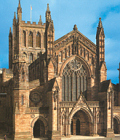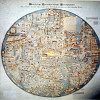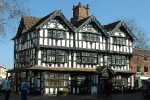 Hereford The Historic Capital City of the Wye Valley Hereford The Historic Capital City of the Wye Valley
A historic centre of international importance, the magnificent Hereford Cathedral hosts Europe's oldest Music Festival every three years- The Three Choirs Festival
 The award winning Mappa Mundi centre houses the world famous map itself plus the two most extensive Chained Libraries in existence. all saints church has one of england's most imaginative restoration schemes, including a thriving restaurant. The award winning Mappa Mundi centre houses the world famous map itself plus the two most extensive Chained Libraries in existence. all saints church has one of england's most imaginative restoration schemes, including a thriving restaurant.
Hereford is a city of fascinating museums- Hereford museum  and Art Gallery runs a regular programme of temporary exhibitions on Heritage and the Arts. The Old House is an impressive museum in the centre of Hereford and the Cider museum's exhibits are gigantic with tasting's on offer to excite the palate. and Art Gallery runs a regular programme of temporary exhibitions on Heritage and the Arts. The Old House is an impressive museum in the centre of Hereford and the Cider museum's exhibits are gigantic with tasting's on offer to excite the palate.
The waterworks museum outside the city includes one of the largest working triple expansion steam engines in Britain.
 The courtyard centre for the Arts is a stunning modern venue for all the performing arts, including professional productions and local community companies: there is an art gallery and lively restaurant. The courtyard centre for the Arts is a stunning modern venue for all the performing arts, including professional productions and local community companies: there is an art gallery and lively restaurant.
Hereford is a city of great antiquity. Its medieval bridge across the River Wye and the  Cathedral Church of the Blessed Virgin Mary and St Ethelbert towering above it, stand as monuments to its distinguished past. The City dates from the 7th century and the Cathedral from 1079 AD, making it one of the oldest in England. Its true origins may by earlier, its strategic position being based on geography as much as politics. Hereford is situated amid extensive rural landscape close to the Welsh border in the Cathedral Church of the Blessed Virgin Mary and St Ethelbert towering above it, stand as monuments to its distinguished past. The City dates from the 7th century and the Cathedral from 1079 AD, making it one of the oldest in England. Its true origins may by earlier, its strategic position being based on geography as much as politics. Hereford is situated amid extensive rural landscape close to the Welsh border in the United Kingdom. The area is devoted primarily to arable and livestock farming United Kingdom. The area is devoted primarily to arable and livestock farming  in equal measure together with extensive woodland cultivation, forestry, plant husbandry, apple and soft fruit growing. Hereford is the home of the largest cider maker in the world and was the birthplace of the famous Hereford breed of cattle. The city is a gateway to Mid and SW Wales and lies on the the important road and rail links between South Wales and the NW of England. in equal measure together with extensive woodland cultivation, forestry, plant husbandry, apple and soft fruit growing. Hereford is the home of the largest cider maker in the world and was the birthplace of the famous Hereford breed of cattle. The city is a gateway to Mid and SW Wales and lies on the the important road and rail links between South Wales and the NW of England.
Locally produced high quality food and drink are an increasingly important element in the quality of lifestyle of Herefordshire…equally appreciated by visitors and residents. A benign climate and rich red fertile soil have long made Herefordshire famous for cattle, sheep, cider and hops: now increasingly vineyards are making a significant contribution to this gourmet’s paradise. Visit some of the producers at work – cheese production near Leominster and countywide, many cider producers open their doors to visitors.
Hereford owes its origins to its strategic military position on the north bank of the River Wye. Taking advantage of a large gravel mound overlooking a reliable fording place across the river, Saxon settlers fortified the site as a defence against the marauding Welsh. This occurred during the early part of the 7th century. The town grew quickly, receiving its first bishop, Putta, in 676 AD. Its military role was expanded following the Norman conquest in 1066 AD, when it became a royal demesne, attaining its greatest significance during the 13th century. During this time the castle was extended to occupy the entire southeast quarter of the city. A twelve foot high, sandstone perimeter wall with six gatehouses and semicircular bastions at intervals, replaced the existing earth and timber palisade. City status was granted in 1189 AD by decree of Richard I. The Charter relating to this, and others more recent, remain intact. |